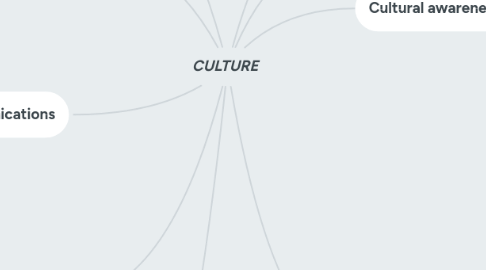
1. Language
1.1. As a diffuser of culture
1.2. As a stabilizer of culture
2. How cultures form and change
2.1. Sources of change
2.1.1. Change by choice
2.1.2. Change by imposition
3. Communications
3.1. Kinds of languages
3.1.1. Spoken and written
3.1.2. Silent
3.1.2.1. Colors
3.1.2.2. Distance
3.1.2.3. Time and punctuality
3.1.2.4. Body language
3.1.2.5. Prestige
4. Definition
4.1. Learned norms based on the values, attitudes and beliefs of a group of people
4.1.1. "People factor"
4.1.1.1. Sensitivity and adjustment
4.1.1.2. Cultural collision
4.1.1.3. Cultural diversity
5. Dealing with cultural differences
5.1. Host society acceptance
5.2. Ability to adjust
5.3. Company and management orientations
5.3.1. Ethnocentrism
5.3.2. Polycentrism
5.3.3. Geocentrism
5.4. Strategies for instituting change
5.4.1. Value systems
5.4.2. Cost benefit analysis of change
5.4.3. Resistance to too much change
5.4.4. Participation
5.4.5. Reward sharing
5.4.6. Opinion leadership
5.4.7. Cultural bridges
5.4.8. Timing
5.4.9. Learning abroad
6. The idea of a "nation"
6.1. "Nation" as a point of reference
6.1.1. The nation as cultural mediator
7. Religion as a cultural stabilizer
8. Cultural awareness
8.1. Little learning goes a long way
9. Behavioral practices affecting business
9.1. Issues in social stratification
9.1.1. Individual qualifications and their limitations
9.2. Relationship preferences
9.2.1. Power distance
9.2.2. Individualism versus collectivism
9.3. Information and task processing
9.3.1. Idealism versus pragmatism
9.3.2. Monochronic versus poluchronic culturees
9.3.3. Perception cues
9.3.4. Information proccesing
9.3.5. Obtaining information
9.3.5.1. Low context versus high context cultures
9.4. Work motivation
9.4.1. Hierarchies of needs
9.4.2. Performance and achievement
9.4.3. Materialism and motivation
9.4.4. Expectation of success and reward
9.5. Risk-taking behavior
9.5.1. Future orientation
9.5.2. Uncertainty avoidance
9.5.3. Trust
9.5.4. Fatalism
